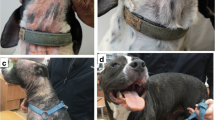Abstract
Canine demodicosis is a refractory skin disease caused by excessive proliferation of mite Demodex canis. Despite availability of several treatment options, the disease poses a great challenge to clinicians for its long term management as some drugs may be ineffective or toxic. Present report describes successful treatment of two refractory cases of canine demodicosis using homeopathy medicine. After oral administration of Graphitis 200 C two drops once daily for 2 months, complete cure from the disease was observed. No adverse health effects of the medication were recorded during the treatment. Thus, it may be concluded that homeopathy medicine may be used safely for long-term management of canine demodicosis.



Similar content being viewed by others
References
Aujla RS, Singla LD, Juyal PD, Gupta PP (2000) Prevalence and pathology of mange-mite infections in dogs. J Vet Parasitol 14:45–49
Bettenay S (1998) A double-blind trial evaluating homeopathic drops in the treatment of atopy in 20 dogs. In: Kwochka KW, Willemse T, Von Tscharner C (eds) Advances in veterinary dermatology, vol 3. Butterworth-Heinemann, Boston, pp 508–509
Ghubash R (2006) Parasitic miticidal therapy. Clinical Tech Small Anim Pract 21:135–144
Gortel K (2006) Update on canine demodicosis. Vet Clinics North Am Small Anim Pract 36:229–241
Hill PB, Hoare J, Lau-Gillard P, Rybnicek R, Mathie T (2009) Pilot study of the effect of individual homeopathy on the pruritus associated with atopic dermatitis in dogs. Vet Rec 164:364–370
Hugnet C, Buronrosse F, Pineau X, Cadore JL, Lorgue G, Berny PJ (1996) Toxicity and kinetics of amitraz in dogs. Am J Vet Res 57:1506–1510
Merola VM, Eubig PA (2012) Toxicology of avermectins and milbemycins (macrocylic lactones) and the role of P-glycoprotein in dogs and cats. Vet Clinics North Am Small Anim Pract 42:313–333
Muller RS (2004) Treatment protocols for demodicosis: an evidence-based review. Vet Dermatol 15:75–89
Paradis M (1999) New approaches to the treatment of canine demodicosis. Vet Clin North Am Small Anim Pract 29:1425–1436
Scott DW, William H, Miller Jr, Senter DA, Cook CP, Kirker JE, Shaun MC (2002) Treatment of canine atopic dermatitis with a commercial homeopathic remedy: a single-blinded, placebo-controlled study. Can Vet J 43:601–603
Sood NK, Mekkib B, Singla LD, Gupta K (2012) Cytopathology of parasitic dermatitis in dogs. J Parasit Dis 36:73–77
Tarallo VD, Lia RP, Sasanelli M, Cafarchia C, Otranto D (2009) Efficacy of amitraz plus metaflumizone for the treatment of canine demodicosis associated with Malassezia pacydermatitis. Parasit Vectors 2:13. doi:10.1186/1756-3305-2-13
Urquhart GM (1996) Veterinary parasitology. 2nd edn. Blackwell Publishing, ISBN 0-632-04051-3
Author information
Authors and Affiliations
Corresponding author
Rights and permissions
About this article
Cite this article
Ranjan, R., Dua, K., Turkar, S. et al. Successful management of refractory cases of canine demodicosis with homeopathy medicine Graphitis. J Parasit Dis 38, 417–419 (2014). https://doi.org/10.1007/s12639-013-0269-6
Received:
Accepted:
Published:
Issue Date:
DOI: https://doi.org/10.1007/s12639-013-0269-6




